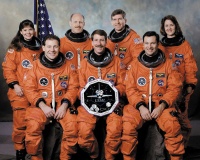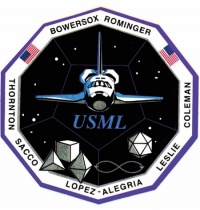STS-73
From The Space Library
 | |
| Organization | NASA-Office of Space Flight (United States) |
|---|---|
| Mission type | Human Crew |
| Launch date | October 20, 1995 |
| Launch vehicle | Space Shuttle |
| Launch site | Cape Canaveral, United States |
| COSPAR ID | 1995-056A |
| Inclination | 39 degrees |
| Experiments | Here |
| Alternate Names | 23688 |
| Additional Information | Here |
| Data Collection | Here |
| Payload Mass Up | 15250 kg |
| Payload Mass Down | 15282.73 kg |
| Orbiter | Columbia |
| Lift Off Mass | 2,055,245.00 kg |
| Orbiter Weight at Liftoff | 116,891.82 kg |
| Orbiter Weight at Landing | 104,620.00 kg |
| Landed | Concrete runway 33 at Kennedy Space Center, Fla. |
| Orbits of Earth | 256 |
| Orbital Altitude | 150 nautical miles (173 statute miles) |
Contents |
[edit] Crew
- Commander: Kenneth D. Bowersox
- Pilot: Kent V. Rominger
- Payload Commander: Kathryn C. Thornton
- Mission Specialist 1: Catherine G. "Cady" Coleman
- Mission Specialist 2: Michael E. Lopez-Alegria
- Mission Specialist 3:
- Mission Specialist 4:
- Mission Specialist 5:
- Payload Specialist 1: Albert Sacco Jr.
- Payload Specialist 2: Fred W. Leslie
ISS/Mir Crew Transport
[edit] Mission
STS 73 was a US shuttle flight launched from Cape Canaveral. The mission carried a spacelab to carry out microgravity experiments related to fluid physics, material science, protein crystals, and combustion science. The second United States Microgravity Laboratory (USML-2) Spacelab mission was the prime payload on STS-73. The 16-day flight continued a cooperative effort of the U.S. government, universities and industry to push back the frontiers of science and technology in "microgravity", the near-weightless environment of space. Some of the experiments carried on the USML-2 payload were suggested by the results of the first USML mission that flew aboard Columbia in 1992 during STS-50. The USML-1 mission provided new insights into theoretical models of fluid physics, the role of gravity in combustion and flame spreading, and how gravity affects the formation of semiconductor crystals. Data collected from several protein crystals grown on USML-1 have enabled scientists to determine the molecular structures of those proteins. USML-2 built on that foundation. Technical knowledge gained had been incorporated into the mission plan to enhance procedures and operations. Where possible, experiment teams had refined their hardware to increase scientific understanding of basic physical processes on Earth and in space, as well as to prepare for more advanced operations aboard the international Space Station and other future space programs. USML-2 experiments included the Surface Tension Driven Convection Experiment (STDCE), the Drop Physics Module, the Drop Dynamics Experiment; the Science and Technology of Surface-Controlled Phenomena experiment; the Geophysical Fluid Flow Cell Experiment; the Crystal Growth Furnace, the Orbital Processing of High Quality Cadmium Zinc Telluride Compound Semiconductors experiment; the Study of Dopant Segregation Behavior During the Crystal Growth of Gallium Arsenide (GaAs) in Microgravity experiment; the Crystal Growth of Selected II-VI Semiconducting Alloys by Directional Solidification experiment; the Vapor Transport Crystal Growth of Mercury Cadmium Tellurida in Microgravity experiment; the Zeolite Crystal Growth Furnace (ZCG), the Interface Configuration Experiment (ICE), the Oscillatory Thermocapillary Flow Experiment; the Fiber Supported Droplet Combustion Experiment; the Particle Dispersion Experiment; the Single-Locker Protein Crystal Growth experiment; (including the Protein Crystallization Apparatus for Microgravity (PCAM) and the Diffusion-controlled Crystallization Apparatus for Microgravity (DCAM)). the Crystal Growth by Liquid-Liquid Diffusion, the Commercial Protein Crystal Growth experiment; the Advanced Protein Crystallization Facility, Crystallization of Apocrystacyanin C experiment; Crystal Structure Analysis of the Bacteriophage Lamda Lysozyme, Crystallization of RNA Molecules Under Microgravity Conditions experiment; Crystallization of the Protein Grb2 and Triclinic Lysozyme experiment; Microgravity Crystallization of Thermophilic Aspartyl-tRNA Synthetase and Thaumatin experiment; Crystallization in a Microgravity Environment of CcdB experiment; A Multivariate Analysis of X-ray Diffraction Data Obtained from Glutathione S Transferase experiment; Protein Crystal Growth: Light-driven Charge Translocation Through Bacteriorhodopsin experiment; Crystallization of Ribosome experiment; Crystallization of Sulfolobus Solfataricus Alcohol Dehydrogenase experiment; Crystallization of Turnip Yellow Mosaic Virus, Tomato Aspermy Virus, Satellite Panicum Mosaic Virus, Canavalin, Beef Liver Catalase, Concanavalin B experiment; Crystallization of the Epidermal Growth Factor (EGF); Structure of the Membrane-Embedded Protein Complex Photosystem I; Crystallization of Visual Pigment Rhodopsin; Commercial Generic Bioprocessing Apparatus; Astroculture Facility and Experiment. Spacelab Glovebox Facility experiments include the Zeolite Crystal Growth Glovebox, Protein Crystal Growth Glovebox and the Colloidal Disorder-Order Transitions. USML-2 flight controllers and experiment scientists directed science activities from NASA's Spacelab Mission Operations Control facility at the Marshall Space Flight Center. In addition, science teams at several NASA centers and universities monitored and supported operations of a number of experiments. Other payloads on board included the Orbital Acceleration Research Experiment (OARE), Space Acceleration Measurement System (SAMS), Three Dimensional Microgravity Accelerometer (3DMA), Suppression of Transient Accelerations By Levitation Evaluation (STABLE) and the High-Packed Digital Television Technical Demonstration system.
[edit] EVA
[edit] Payload
United States Microgravity Laboratory (USML) 2; Orbital Acceleration Research Experiment (OARE)
[edit] Books about the Space Shuttle Program
Buy This Book Click here |
Buy This Book here |
Buy This Book Click here |
Buy This Book Click here |





